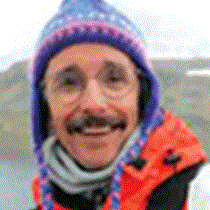Le Conte Inlet, Petersburg
We awoke to bluebird skies and dappled waters of glacier ice as we approached the entrance to Le Conte Inlet. Not a cloud above, a ripple below. The sea was a mirror, the air a prism, the light like ambrosia as the sun climbed over the coast range and softened itself on our warming faces. “Good morning,” we whispered to each other, as if our voices, spoken any louder, would break the spell. Loons called. A bald eagle flew by. Somebody said something about paradise.
A couple hours later found us in our Zodiacs, cruising through constellations of artfully shaped blue ice – icebergs, growlers and bergy bits – calved from the Le Conte Glacier (the southernmost tidewater glacier in North America) and stranded on the shallow bar, melting into summer, each a mandala, a testimony to impermanence. We watched them break apart, roll over, and drip into the sea. Altogether fitting, in a way. It’s the processes that last forever, not their players. That’s what makes geology so timeless.
Late morning, Dr. Fred Sharpe, biologist, appropriately disheveled, rail-thin and academic, funded by Lindblad and National Geographic Expeditions, visited us in the lounge and answered our questions about humpback whale behavior. How fitting that he specializes in whale acoustics and the evolving complexities of language, as he himself was so articulate. He made us feel as if we, too, were evolving. Having once slaughtered whales, we now celebrate them. “Give yourselves a round of applause,” he said. “The numbers of humpback whales are increasing every summer in Alaska. They’re doing well. It takes a vibrant ocean to achieve this. All is not lost. We can still save this planet.”
Lunch was delicious. Early afternoon, we pulled into the hard-working, roll-up-your-sleeves fishing town of Petersburg, and set off on a suite of activities. Dockside, we watched a local fishing guide artfully flense a halibut (the kids wide-eyed). While some of us fished, others went flight-seeing (by floatplane) over the Patterson Glacier, Stikine Icefield, and Le Conte Glacier, winging past granite mountain spires and alpine shoulders. Such magnificence, every contour a beautiful icescape/seascape, as if long tendrils of glaciers were clasping fingers of the sea, two brothers made of water, embracing. For exercise, many of us used bicycles to zip around town, while others hiked a yellow cedar boardwalk (only one foot wide) up onto a picturesque muskeg.
Shortly before dinner, Dan Lesh, an energy coordinator from the Southeast Alaska Conservation Council (also supported by Lindblad and National Geographic Expeditions), spoke about conservation in the Tongass National Forest. Like Fred Sharpe, Dan was young, passionate and bright, and perhaps most important to the kids – friendly.
All in all, a grand day. The best day. A typical day. We felt luckier than the richest gold miner, for our motherlode was what’s always been here, the land and sea, the forest and fish, Alaska just being itself.
A poem by one of our guests:
“Alaska”
(by Jordan Harrison, Guest, age 15)
Why would one voyage to a frigid land
When temp’rate waters free of chill and rime
Lie to the south, and teem with sun and sand?
To see grandeur both land and maritime
To ogle bears of brawn and salmon spawn
In woods of green and crystal sparkling streams
To cherish breeching whales until they’re gone
That is Alaska’s charm and lure it seems.
Why would one chop and burn and drill this state
Until oblivion engulfs the pride
And treasure of a nation strong and great?
Instead let’s keep intact the great outside.
God bless and keep this ship, its crew, and guests
But save Alaska’s state of mind the best.




